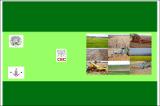Por favor, use este identificador para citar o enlazar a este item:
http://hdl.handle.net/10261/7715COMPARTIR / EXPORTAR:
 SHARE
BASE SHARE
BASE
|
|
| Visualizar otros formatos: MARC | Dublin Core | RDF | ORE | MODS | METS | DIDL | DATACITE | |

| Título: | Influencia del laboreo y del sistema de cultivo en el secuestro de carbono orgánico en el suelo en agroecosistemas semiáridos del Valle del Ebro |
Autor: | Álvaro-Fuentes, Jorge CSIC ORCID | Director: | Arrúe Ugarte, José Luis CSIC ORCID; López Sánchez, María Victoria CSIC ORCID; Cantero-Martínez, Carlos CSIC ORCID | Palabras clave: | Laboreo de conservación Tillage Agroecosistemas semiáridos Semiarid Agroecosystems |
Fecha de publicación: | 2006 | Editor: | Universidad de Lleida CSIC - Estación Experimental de Aula Dei (EEAD) |
Citación: | Tesis doctorales EEAD | Serie: | TD-2006 | Resumen: | [EN] The main objective of this research was to evaluate the effects of tillage and cropping system on soil organic C sequestration in dryland semiarid agroecosystems of the Ebro valley, as well as the factors controlling this C stabilization. The study was conducted at three long-term tillage experiments located at Selvanera (Lleida province), Agramunt (Lleida province) and Peñaflor (Zaragoza province). At Selvanera (475 mm of mean annual precipitation and a Xerocrept fluventic soil) four tillage systems were compared (conventional tillage, subsoil tillage, reduced tillage and no-tillage) under a wheat-barley-wheat-rapeseed rotation. At Agramunt (430 mm of mean annual precipitation and a Xerofluvent typic soil) four tillage systems were compared (conventional tillage, subsoil tillage, reduced tillage and no-tillage) under a wheat-barley. At Peñaflor (390 mm of mean annual precipitation and a Xerollic calciorthid soil) three tillage systems were compared (conventional tillage, reduced tillage and no-tillage) and two cropping systems (a barley-fallow rotation and a continuous barley system). In order to determine C ouputs, measurements of soil CO2 emissions were carried out during three cropping seasons (2002-2003, 2003-2004, 2004-2005) at Peñaflor and during two (2003-2004, 2004-2005) at Agramunt and Selvanera. Soil CO2 measurements were performed every 15 days and during tillage with greater frequency. To quantify C inputs, root biomass and straw production were measured at harvest. Soil aggregation dynamics was monitored during two cropping seasons at the two cropping systems of Peñaflor by measuring dry aggregate distribution and water aggregate stability. Three soil samplings were made after harvest to study the influence of organic matter fractions on soil aggregation dynamics (2002-2003 and 2003-2004 cropping seasons) and soil organic C content, particulate organic matter and mineral-associated C (2004-2005 cropping season). In the upper 5 cm of soil depth, no-tillage sequestered 50-100% more organic C and 20-50% more particulate organic matter and mineral-associated C than conventional tillage. However, this trend was inverted at lower depths where no-tillage showed the lowest values and conventional tillage the greatest. Cropping system intensification led to a greater soil organic C content in all the tillage systems. The study of the soil organic matter fractions in relation with the dynamics of soil aggregation demonstrated that no-tillage led to a greater macroaggregate stability and, thus, to a greater long-term organic C sequestration in these macroaggregates. This organic C stabilized under no-tillage macroaggregates consisted of particulate organic matter occluded within the microaggregates protected by the macroaggregates. The temporal variation of soil aggregation was affected by crop growth, with a drop of the stability of soil macroaggregates when crop died. During the cropping season, soil CO2 emissions to the atmosphere were 30% and 5% greater under conventional tillage and reduced tillage, respectively than under no-tillage. Soil CO2 emissions at the time of tillage were 100% and 50% greater under conventional tillage and reduced tillage, respectively, than under no-tillage. In all the cases, soil organic C balances showed C looses in all tillage and cropping systems. However, under no-tillage soil C looses were 20-50% lower than under conventional tillage. Finally, the barley-fallow rotation showed greater C losses due to reduction in the soil C inputs during the long fallow phase. | URI: | http://hdl.handle.net/10261/7715 |
| Aparece en las colecciones: | (EEAD) Tesis |
Ficheros en este ítem:
| Fichero | Descripción | Tamaño | Formato | |
|---|---|---|---|---|
| 2006_Tesis_ÁlvaroJ.pdf | 2,83 MB | Adobe PDF |  Visualizar/Abrir |
CORE Recommender
Page view(s)
363
checked on 24-abr-2024
Download(s)
354
checked on 24-abr-2024
Google ScholarTM
Check
NOTA: Los ítems de Digital.CSIC están protegidos por copyright, con todos los derechos reservados, a menos que se indique lo contrario.
